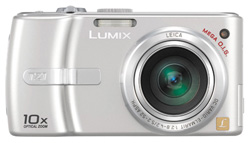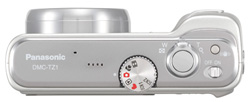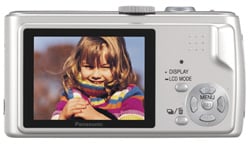Panasonic Lumix DMC-TZ1
-
-
Written by Gordon Laing
Panasonic DMC-TZ1 design and controls
Panasonic’s TZ1 is a plain-looking compact camera which gives few physical clues to the powerful 10x optical zoom housed within other than a badge in the bottom left corner. It’s available in black, silver or blue, although all three variations may not be sold in every region.

Measuring 112x58x40mm and weighing 262g with battery and memory card, the TZ1 may be chunkier than the slimmest compacts out there, but in no way bulky or inconvenient to carry around. Put it this way, it can certainly be described as pocket-sized, so long as the pocket’s in your jeans or jacket rather than the front of your shirt.
There’s nothing wrong with a little chunkiness anyway, as it allows the TZ1 to sport a larger than average grip for a compact which makes it much easier to hold than the slimmest models out there. The build quality is also good with the body feeling solid and free of creaks.

Alongside the main mode dial on the top surface you’ll find the power switch, optical stabilisation button, and a zoom lever around the shutter release button. The mode dial switches between normal picture, macro, movie and simple modes along with playback and two programmable scene selections from a choice of 19.
There’s no manual mode, nor the ability to select specific shutter speeds or apertures, but careful use of exposure compensation and scene presets can achieve a wide range of creative effects. See the Features section for details on the exposure modes and their options.
The rest of the controls are concentrated in the lower right corner on the back of the camera. Four buttons arranged like a joypad are used to navigate menu options, scroll across images during magnified playback, or select various options during shooting. A button in the middle of these four brings up the main menu system or confirms settings.

Pressing the top of the four buttons while shooting presents the exposure compensation settings, offering the traditional +/-2EV range for darkening or brightening exposures. Pressing the bottom button shows the last image taken (or viewed during playback), and like playback mode, you can magnify using the zoom lever.
Pressing the left button activates a 10 second self-timer, and pressing it a second time reduces it to two seconds. Finally, pressing the right button cycles through the five options for the built-in flash: Auto, Auto with red-eye reduction, Forced on (with optional red-eye reduction if you’re using the Party or Candle Light scene presets), Slow sync with red-eye reduction and Forced off.
Two further buttons operate the LCD and continuous shooting options – see Features page for more details.
Connectivity
A single small door on the left side of the body opens to reveal DC-in and a combined USB / video out port. A larger door under the grip side of the body houses the battery and memory card.
The TZ1 is powered by a 1000mAh Lithium Ion battery pack and is supplied with a mains recharger. Panasonic claims each charge is good for 250 shots under CIPA conditions. During our first test period we fired-off just under 100 images over three days under a variety of conditions, including sub-zero temperatures, before it needed recharging.




